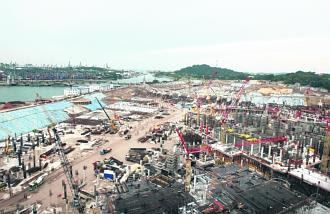Ivy Sam, Yahoo News 23 Jul 08;
Malaysia's plan to build a series of hydroelectric dams on Borneo island threatens the World Heritage status of a key national park, environmentalists warned Wednesday.
Parts of Mulu National Park in Sarawak state would be flooded if the proposed 220 megawatt hydropower plant on the Tutoh river went ahead, said Swiss-based group the Bruno Manser Fund (BMF).
Activists warned the damage would change the boundary of the park, which could see its World Heritage status revoked under the regulations of the UN cultural body UNESCO.
The sensitive 52,864 hectare (130,627 acre) park contains some 3,500 species of plants with 109 species of palms, according to the UNESCO website.
The park is dominated by Gunung Mulu, a 2,377 metre (7,799 feet) high sandstone pinnacle containing at least 295 kilometres of explored caves that are home to millions of cave swiftlets and bats, it said.
"One of the requirements under the heritage site listing is that no boundary changes should be done in the area without prior consent from UNESCO," said Gurmit Singh, chairman of the Centre for Environment, Technology and Development Malaysia.
"It has asked the Malaysian government to clarify this but they have not received a reply so far and it has been a month," he said.
"If there is a change without consent... then UNESCO can revoke the heritage site listing for the park."
Deputy Energy, Water and Communications Minister Joseph Salang Gandum said the proposed Tutoh dam by state energy firm Sarawak Energy Berhad was "necessary to meet energy demands in the state", according to the Star daily.
But BMF said ethnic groups who live in the national park would have to be relocated if the project went ahead.
"If these plans were to be realized, several thousand natives would lose their traditional lands in the Bornean rainforest and would have to be relocated," it said in a statement.
The Tutoh dam is part of plans for 12 new hydroelectric projects in Sarawak and with the 2,400 megawatt Bakun Dam project, will increase the state's total power generating capacity by 600 percent in 2020, the Star reported.
Currently, the state's power production of 933 megawatts is enough to meet its daily needs, but the government plans to expand the aluminium smelting industry which will need more power, the paper reported.
The Star said power from the 12 new hydroelectric projects will meet this increased demand, with excess output transferred to peninsular Malaysia to help meet the rest of the country's energy needs.
However, environmentalists disagree with the government's forecast.
"The projects...are not sustainable. The current Bakun Dam would be enough for the aluminium smelter the state has planned to build right now," Singh said.
"Even if they could generate that much (excess) power, it would be very costly to bring the electricity to peninsular Malaysia via undersea cables."
Malaysia already faces fierce criticism over the environmental impact of the Bakun dam project in Sarawak, which involves flooding an area the size of Singapore island.
Some 10,000 residents have had to evacuate the project site, including the indigenous Penan tribe, a nomadic people who live off the forests in Borneo. The plight of the Penan was made famous in the 1990s by environmental activist Bruno Manser, who campaigned to protect their way of life and fend off the loggers. He vanished in 2000, a suspected victim of foul play.
Outcry over Sarawak's plans for 12 dams
Environmentalists say projects could cause a national park to lose its World Heritage status
Straits Times 24 Jul 08;
PETALING JAYA - SARAWAK plans to build 12 hydroelectric dams to meet its future industrialisation needs, but environmentalists say the projects threaten the World Heritage status of a key national park.
Deputy Energy, Water and Communications Minister Joseph Salang Gandum said the remote dams were necessary to meet energy demands.
The 12 new dams are in addition to the 2,400MW Bakun dam.
The projects will increase the total generating capacity of Sarawak to 7,000MW by 2020 - from the current 933MW.
The plans were part of a presentation - titled Chinese Power Plants In Malaysia - at a forum in Nanning, China, last October.
Companies from China were expected to design, build and commission the dams, according to the presentation.
Officials say the new capacity is needed as Sarawak wants to expand its aluminium-smelting industry.
But environmentalist Gurmit Singh expressed concerns, saying the proposal to build dams and then look for energy-guzzling industries was wrong.
'This is also a typical example of the 'not-in-my-backyard' mentality where a country puts its polluting industries in other countries,' he said, referring to the foreign companies being lured to start aluminium smelter and other energy-guzzling industries in Sarawak.
There is also concern that parts of Mulu National Park in Sarawak would be flooded if a proposed dam on Tutoh river was built, said the Bruno Manser Fund (BMF), a Swiss-based group.
The 52,864ha park contains some 3,500 species of plants, including 109 species of palms, according to the Unesco website.
The park is dominated by Gunung Mulu, a 2,377m-high sandstone pinnacle containing at least 295km of caves that are home to millions of cave swiftlets and bats, it said.
Activists warned that the flooding would change the boundary of the park, which could see its World Heritage status being revoked.
'One of the requirements under the heritage site listing is that no boundary changes should be done in the area without prior consent from Unesco,' said Mr Singh.
BMF said ethnic groups who live in the national park would have to be relocated if the project went ahead.
Some 10,000 residents were evacuated from the Bakun project site.
THE STAR/ASIA NEWS NETWORK, AGENCE FRANCE-PRESSE
Read more!






